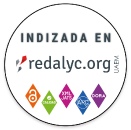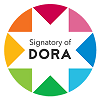Risk factors of the metabolic syndrome related to nutritional status in workers of an electric company
DOI:
https://doi.org/10.37135/ee.004.06.03Keywords:
dyslipidemias, obesity, metabolic syndrome, nutritional statusAbstract
A descriptive, cross-sectional and observational study was carried out in Empresa Eléctrica de Riobamba SA (EERSA) in order to identify the risk factors of the metabolic syndrome related to the nutritional status in its workers, during the year 2015. The entire population was part of this research, which was constituted by the medical records of the 105 workers between 25 and 60 years of age from all areas of that institution, who agreed to be part of this research. 73% of the participants were male and the mean age was 44 years. The data collected allowed to establish the predominance of overweight individuals was 50%. The presence of this predisposing factor was observed in 73% of the participants in the study (graph 2) considering the occurrence of a cardiovascular event in the next 10 years (according to the Framinghan score). It was observed that the presence of dyslipidemia prevailed in the study population, as well as high cholesterol levels in 58.1% of individuals; while those relative to LDL were low at 52.38%. The correlation analysis made possible to establish that this was positive and statistically significant in the case of visceral fat mass with respect to body mass index and waist circumference.
Downloads
References
Fajardo E, Camargo Y, Buitrago E, Peña L, Rodríguez L. Estado nutricional y preferencias alimentarias de una población de estudiantes universitarios en Bogotá. rev. fac. med [Internet]. 2016 July [citado 2019 Feb 04]; 24(2): 58-65. Disponible en: http://www.scielo.org.co/scielo.php?script=sci_arttext&pid=S0121-52562016000200006&lng=en. http://dx.doi.org/10.18359/rmed.2641.
Guerra C, Vila J, Apolinaire J, Cabrera A, et al. Factores de riesgo asociados a sobrepeso y obesidad en adolescentes. MediSur 2009; 7(2): 25-34.
Organización Mundial de la Salud. Salud de la madre, el recién nacido, del niño y del adolescente. New York: OMS; 2016.
Pereira-Rodriguez J, Melo-Ascanio J, Caballero-Chavarro M, Rincon-Gonzalez G, Jaimes-Martin T, Niño-Serrato R. Síndrome Metabólico. Apuntes de interés. Rev Cubana Cardiol Cir Cardiovasc [Internet]. 2016 [citado 2018 Feb 4]; 22(2): [aprox. 8 p.]. Disponible en: http://www.revcardiologia.sld.cu/index.php/revcardiologia/article/view/592.
Saucedo-Molina TJ, Rodríguez-Jiménez J, Oliva-Macías LA, Villarreal-Castillo M, León-Hernández RC, Fernández-Cortés TL. Relación entre el índice de masa corporal, la actividad física y los tiempos de comida en adolescentes mexicanos. Nutr Hosp [Internet]. 2015 Sep [citado 2018 Ene 14]; 32(3): 1082-1090. Disponible en: http://scielo.isciii.es/scielo.php?script=sci_arttext&pid=S0212-16112015000900017&lng=es. http://dx.doi.org/10.3305/nh.2015.32.3.9331.
Pinos-Mora LP. Análisis de la gestión del riesgo psicosocial y riesgo laboral en empresas públicas de generación, comercialización y distribución de energía eléctrica en Ecuador [Tesis doctoral en Internet]. Badajoz, España: Universidad de Extremadura; 2017 [citado 2017 Oct 21]. Disponible en: http://dehesa.unex.es/bitstream/handle/10662/6433/TDUEX_2017_Pinos_Mora.pdf?sequence=1&isAllowed=y.
Vintimilla-Rojas DA, Moscoso-Sarmiento MF. estado nutricional e intervención dietética al personal administrativo de la Corporación Eléctrica del Ecuador (CELEC EP) Unidad de Negocio Hidropaute. Julio 2014-enero 2015. [Tesis de grado en Internet]. Cuenca, Ecuador: Universidad de Cuenca; 2015. [citado 2017 Oct 21]. Disponible en: http://dspace.ucuenca.edu.ec/bitstream/123456789/21251/1/TESIS.PDF.
Aráuz-Hernández AG, Guzmán-Padilla S, Roselló-Araya M. La circunferencia abdominal como indicador de riesgo de enfermedad cardiovascular. Act Méd Costarricense [Internet]. 2013 [citado 2018 Ene 19]; 55(3): 122-127. Disponible en: http://www.redalyc.org/pdf/434/43428797004.pdf.
Soutelo J, Saban M, Faraj G , Fritz MC1, González J, Barbero MR, Quevedo MV, Lutfi R, Arias P. Relación entre circunferencia de cintura y factores de riesgo metabólicos en mujeres argentinas. Rev argent endocrinol metab [Internet]. 2013 [citado 2018 Ene 11]; 50(1). Disponible en http://www.scielo.org.ar/scielo.php?script=sci_arttext&pid=S1851-30342013000100003.
Pajuelo-Ramírez J, Sánchez-Abanto J, Álvarez-Dongo D, Tarqui-Mamani C, Bustamente-Valdivia A. La circunferencia de la cintura en adolescentes del Perú. An. Fac. med. [Internet]. 2016 Abr [citado 2019 Feb 04]; 77(2): 111-116. Disponible en: http://www.scielo.org.pe/scielo.php?script=sci_arttext&pid=S1025-55832016000200003&lng=es. http://dx.doi.org/10.15381/anales.v77i2.11814.
Buendía-Godoy RG, Zambrano M, Morales A, Alejo A, Giraldo L, Gámez D et al. Perímetro de cintura aumentado y riesgo de diabetes. Acta Med Colomb [Internet]. 2016 Sep [citado 2019 Feb 04]; 41(3): 176-180. Disponible en: http://www.scielo.org.co/scielo.php?script=sci_arttext&pid=S0120-24482016000300176&lng=en.
García A, Niño-Silva L, González-Ruiz K, Ramírez-Vélez R. Volumen de grasa visceral como indicador de obesidad en hombres adultos. Rev. Colomb. Cardiol. [Internet]. 2016 July [cited 2019 Feb 04]; 23(4): 313-320. Disponible en: http://www.scielo.org.co/scielo.php?script=sci_arttext&pid=S0120-56332016000400015&lng=en. http://dx.doi.org/10.1016/j.rccar.2015.12.009.



















